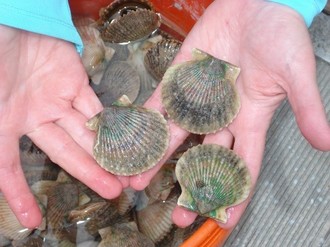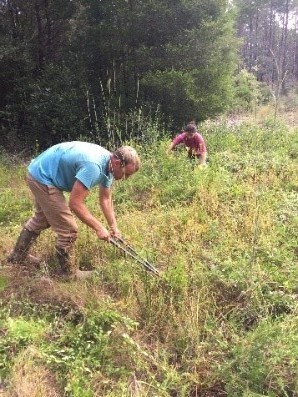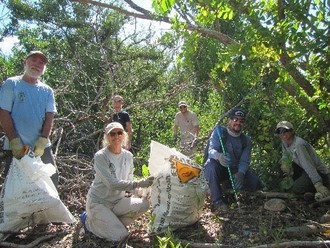|
Our hearts go out to our neighbors, volunteers, staff and friends who were affected by Hurricane Michael. This storm, one of the worst to hit the United States, has forever changed the Florida panhandle. While it will take a long time to recover, we know that Floridians are resilient, strong and can overcome this hardship. We are here to support your recovery in any way we can!
There are still many avenues and opportunities to help. Please consider visiting Volunteer Florida if you would like to volunteer your time or donate to hurricane relief efforts. Please also consider donating to the Fish & Wildlife Foundation’s Hurricane Michael Recovery & Relief Fund to help affected FWC staff continue to recover from the impact of this storm.
— FWC's Volunteer Team
FWC hosts first annual scallop rodeos
By Emily Hardin, Northwest Region Volunteer Coordinator
Cameron Baxley, FWRI staff, gets help from volunteers during the St. Joseph Bay Scallop Rodeo. Photo courtesy of Emily Hardin, FWC.
When you first hear the words “scallop rodeo,” it may conjure up images of someone riding a bucking scallop or racing a scallop around a trio of barrels. While no one was riding scallops at these rodeos, you could say that scallops were being lassoed and rounded up.
Scallop populations in St. Joseph and St. Andrews Bays (Gulf and Bay counties, respectively) have decreased over the past several years. In response, the FWC’s Fish & Wildlife Research Institute initiated an effort to restore bay scallop populations. Part of this effort involves Scallop Sitter volunteers, who “babysit” a cage of scallops throughout their life cycle. The other part of this effort involves the Scallop Rodeos.
The first official Scallop Rodeos were held this past July and August, wherein hundreds of volunteers assisted in gathering up scallops from St. Joseph and St. Andrews Bays. Volunteers came out in droves to enjoy a day on the water with their friends and families while practicing their scalloping techniques. Volunteers collected up to 50 scallops each, which they returned alive to FWC staff. At the end of the rodeo, FWC staff placed the scallops in predator-exclusion cages and then back into the bay.
The cages, approximately 3 feet x 3 feet, house up to 200 scallops each. Inside the cages, the scallops are safe from predation and have an increased chance of successful reproduction. Scallops are broadcast spawners, meaning they release egg and sperm into the water column and “hope for the best.” Individuals are often too far apart from each other, leading to unsuccessful reproduction and low numbers of scallops in the bay. The cages keep the scallops close together, thereby increasing the chances that juvenile scallops will soon populate the bay.
St. Andrews Bay has not had an open recreational scallop harvesting season in several years, as populations have been deemed too low to allow for harvesting. For the Scallop Rodeo, 553 scallops were collected over the course of several hours by a total of 57 volunteers. St. Joseph Bay does still have an open scallop season; however, in recent years, the season has only been open for about a month. The St. Joseph rodeo was held just prior to the opening of the 2018 scallop season. Over 100 volunteers helped to collect 1,123 scallops that will now remain in the bay through the open season and into the spawning season.
While Hurricane Michael may have impacted the effects from these rodeos, we hope to hold more in the future to further increase the scallop populations in the bays. Thank you to all the volunteers who not only helped to collect scallops, but also to those who assisted in constructing the predator-exclusion cages and made the rodeos possible!
 Collected bay scallops. Photo courtesy of the FWC.
Another oyster season on the books
By Emily Hardin, Northwest Region Volunteer Coordinator
 Volunteers assist with oyster restoration surveys in St. Andrews Bay. Photo courtesy of Emily Hardin, FWC.
A little over two years ago, the FWC’s Aquatic Habitat Conservation and Restoration section received funding to restore oyster and seagrass habitat in St. Andrews Bay (Bay County). Since then, 67 individual oyster reefs covering over four acres have been installed in the western portion of the bay. Each August through October, FWC biologists and several volunteers survey the reefs and monitor the progress.
This season, 20 volunteers donated 261 hours of their time to assist in these surveys. Volunteers help in many aspects of the project. For some surveys, volunteers spend the entire day snorkeling along the reefs to assess the percentage of the reef that is covered in oysters. On other days, volunteers brave the heat and remain topside to measure the size of spat found on oyster shells within specific sampling areas. Every day is long and tiring, but also fun and rewarding!
With so much surveying to be completed during the late summer and into fall, our dedicated volunteers make this project possible. Because of you, quality data is collected and utilized to improve the bay ecosystem! We would like to give a special thanks to Vernon Todd, Mark Hyman, Kat Orr and Victoria Strange for their incredible dedication to this project.
National Public Lands Day
By Emily Hardin, Northwest Region Volunteer Coordinator
National Public Lands Day, established in 1994, encourages people across the nation to celebrate their nearby public lands, whether they are managed by local, state or federal agencies. It has become tradition for land managers to host volunteer work days on or around this day, which is celebrated on the fourth Saturday of September. The goal is to inspire people to enjoy nature and gain an appreciation for all the opportunities that public lands provide.
The FWC’s Regional Volunteer Programs took part in celebrating National Public Lands Day by hosting work days across the state. Overall, 27 volunteers contributed about 94 hours to projects geared towards improving public lands for the benefit of people, plants, and wildlife.
 Northwest Region volunteers remove hardwood growth from a Florida bog frog restoration site. Photo courtesy of Emily Hardin, FWC.
In the Northwest Region, volunteers assisted staff with a habitat restoration project in the Yellow River Wildlife Management Area. Volunteers hand cleared overstory growth and vegetation from a site to restore the habitat for the Florida bog frog, a rare amphibian found only in three counties in the Florida panhandle. Three volunteers braved the heat to contribute over 10 hours of work clearing over 1,000 square meters of area.
 Northeast Region volunteers remove invasive natal grass at the Cross Florida Greenway. Photo courtesy of Logan McDonald, FWC.
In the Northeast Region, fifteen volunteers from the FWC and the Florida Department of Environmental Protection removed nonnative natal grass from the Cross Florida Greenway. The natal grass was encroaching on habitat of the endangered longspurred mint and the threatened Florida Scrub-Jay. Volunteers removed 43 bags of the non-native grass!
 Southwest Region volunteers remove invasive rattlebox from Big Pine WEA. Photo courtesy of Brendan O'Connor, FWC.
Volunteers in the Southwest Region spent the day removing invasive showy rattlebox from Big Pine and Chinsegut Wildlife Environmental Area. This invasive plant outcompetes native plants and disturbs natural communities. Six volunteers joined staff to remove the species from approximately four acres and contributed 23 hours.
 South Region volunteers and FWC staff remove debris from the Keys WEA. Photo courtesy of Andrea Pereyra, FWC.
In the South Region, volunteers removed marine debris from the Florida Keys Wildlife Environmental Area. Marine debris poses a high risk to wildlife through entanglement and ingestion, which can lead to starvation, entrapment and death. Three volunteers, along with staff, removed 880 lbs. of trash from a two-acre area.
|